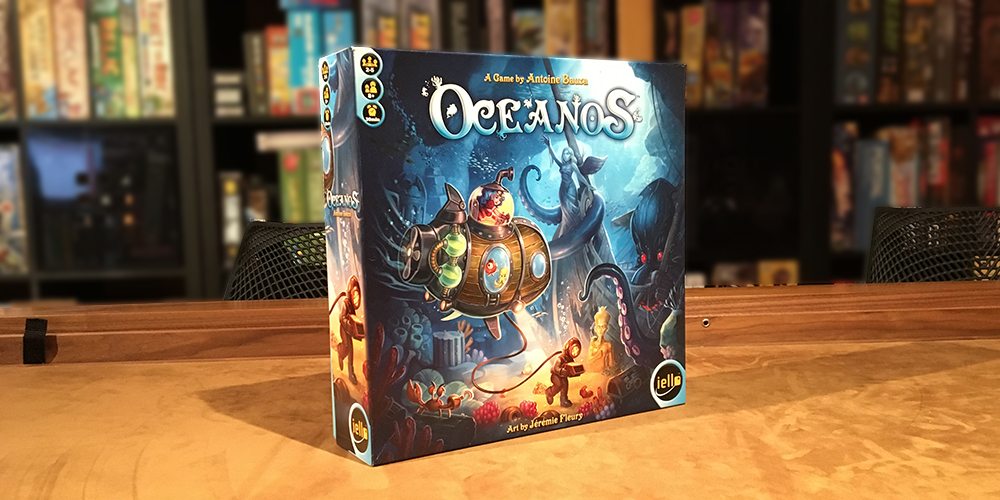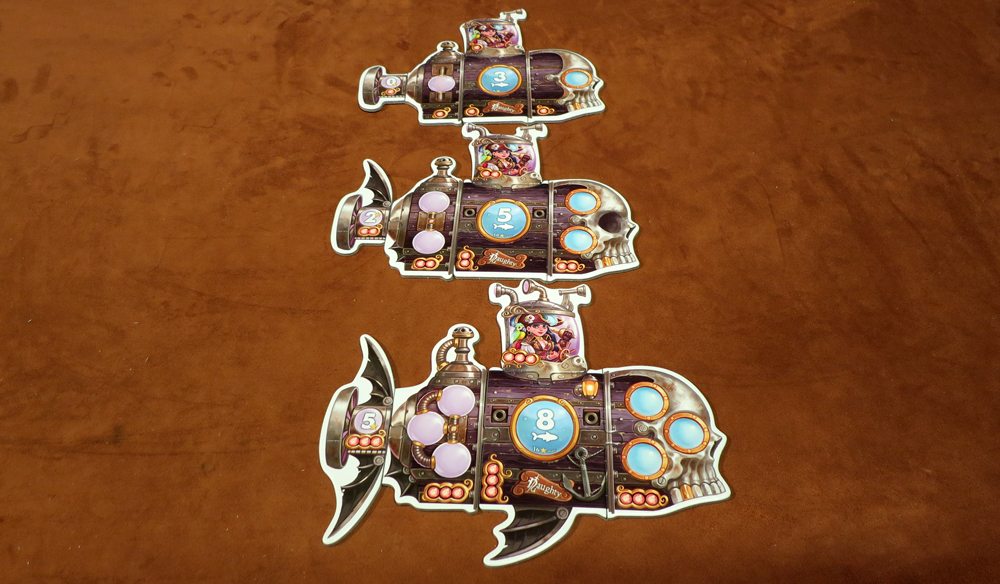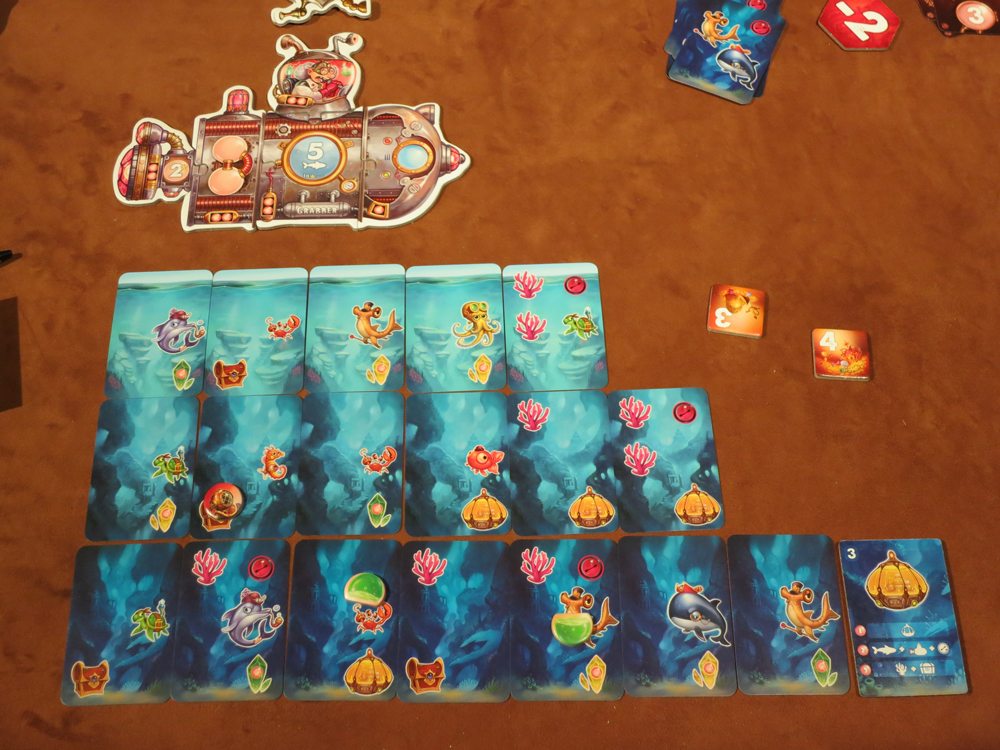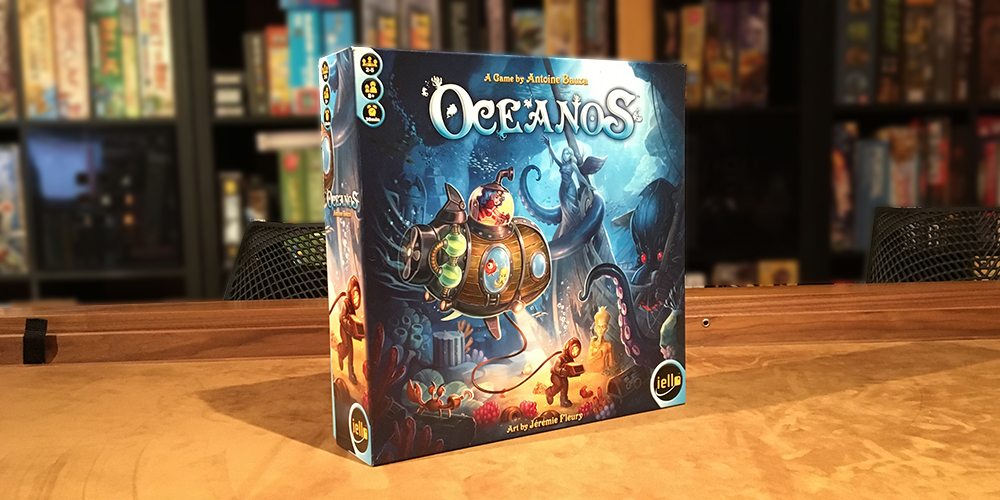
At a Glance
Periscope down! Dive! In Oceanos, 2-5 players age 8 and up can explore the world beneath the waves. Count coral, discover animals, find treasure as you go deep into the dark blue in your submarine. There’s opportunity to upgrade your ship to bring more discoveries home at the end of the game, but watch out for the kraken! Oceanos, from Iello, is a family-friendly game that plays in about 30 minutes.
Components
This is one heavy box. There is a lot of cardboard in it and it is seriously thick stuff. Typically, Iello does a really great job with components and Oceanos exceeds those expectations. Inside the box, you’ll find:
- 135 Exploration cards (40 round 1 cards, 45 for round 2, and 50 for round 3)
- 75 Submarine pieces (15 pieces each for five players)
- 30 Treasure tokens
- 15 Fuel tokens (3 pieces each for five players)
- 15 Scuba Diver tokens (3 pieces each for five players)
- 9 Kraken tokens
- 5 Player aids
- 1 Bag
- 1 Scorebook

Each player gets a character and a beginning submarine, which has five parts: a cockpit, propeller, motor, aquarium, and airlock. Each piece is upgradable to a second and third tier (resulting in 15 pieces per player). The submarine components are interchangeable, with the pieces becoming more elaborate (and offering bigger benefits) as the elements are improved. There were issues with the initial run of the game and some of the die cuts didn’t quite match up. The copy I played had a single replacement part and with its addition, the pieces mostly fit together without problem, but some joined together pretty tightly. After a few plays, they have loosened up a bit. The issue doesn’t affect gameplay, but it’s worth being aware of.
The artwork is partly cartoon, partly fantastical, and altogether beautiful. It’s done by Jérémie Fleury (Timeline Challenge, Histrio, the upcoming Yamataï) and does a great job of setting the theme of undersea exploration. As you sit down to play a game of Oceanos, whether it’s your first or fortieth journey beneath the waves, the components set the scene for an enjoyable game…
How to Play
Each player picks a character and gets all fifteen of its submarine pieces, three fuel tokens, and three scuba tokens. Players also get a player aid before building out the tier one components of their submarines. Next, a single fuel and scuba diver token are added to each ship. To the center of the table, the exploration cards are divided by rounds and shuffled. The Kraken tokens come in three sizes and they are also shuffled before blindly selecting one from each size and stacking them in ascending size in the center. Finally, the treasure tokens are placed in the bag and set aside. Play is ready to begin.
The game takes place over 3 rounds, with each round being composed of 5 turns. A player is chosen as the Expedition Captain, who is responsible for dealing that turn. Exploration cards are dealt to each player according to their submarine, with a card being dealt for each periscope on their cockpits, plus one card. The cockpit is upgradable, so some players may receive more cards as the game progresses.

Players evaluate their cards before choosing one and placing it facedown in front of themselves. Players give remaining cards to the Expedition Captain before simultaneously revealing their held cards. These cards are placed, left to right in a single row for each round. Once placed, they cannot be moved. The Expedition Captain chooses a card from those discarded by the other players before ending the turn. As players select their cards, they can keep an additional card by sacrificing their fuel token(s), which are placed on the card(s) when they are revealed. Responsibility for the Expedition Captain role goes to the player to the left and play continues until five turns have been completed, ending round one.
A round of scoring ensues, which is a good opportunity to talk about the strategy of choosing cards to play, as well as the abilities of different ship components. First, the cards. On each Exploration Card, you’ll see a handful of a half-dozen elements. There are animals, corals, treasure chests, bases, crystals, and kraken eyes.

On the ships, the propellers grant end of round points. You start out with zero, but can work up to five. The motor has up to three reservoirs for fuel tokens and the aquarium can hold animals that you find. As mentioned, the cockpit’s periscopes dictate the number of cards you are dealt each turn. Finally, the number of portholes in the airlock show how many scuba divers you get.
In the row you’ve created for the first round, a player counts the number of unique animals that they’ve found, up to the number allowed by their aquarium. The beginning aquarium allows a player to hold three different animals, each worth two points. Aquariums can be upgraded to 5 and then 8 animals for a total of 10 or 16 points per round. Each player’s round of cards is evaluated for Kraken eyes. The player with the most (or both players if there is a tie) has to take the Kraken token for that round, which may deduct points from their round total(s). Any spent fuel tokens are returned to the ships for use in the following round.

The remaining card icons affect upgrades and end of game scoring. Each time a player plays a crystal (either green or yellow) followed by a base, they may upgrade an element of their submarine. However, to upgrade from a tier 2 piece to a tier 3, the player must play a green and a yellow crystal before the base. The Player Aid is placed at the end of a row at the end of a round and has a base on it that can be used to facilitate an upgrade.
These rules apply to all three rounds, but at the end of the third round, two additional scoring rules come into play. Some cards have coral on them and each player counts up their longest coral reef (orthogonal only, no diagonal cards) and give themselves a point for each coral in that reef.
The final tally to be counted are the Treasures. As cards are played, a player could have deployed a Scuba Diver on a card with a Treasure icon that has just been played. The diver stays on that card until the end of the game. At the end of round three, that diver brings up the Treasure that the token has been placed on and any additional Treasures that are in the column of cards directly above the diver. The player then removes a Treasure token from the bag for each Treasure retrieved. Points from all rounds and categories are totaled and the most points wins.

Why You Should Play
When we saw Oceanos at Gen Con, we were told by the folks at Iello that it was Antoine Bauza’s (Hanabi, 7 Wonders, Tokaido, Takenoko, Ghost Stories) favorite game he’s ever designed, something I shared on Twitter right away. Bauza immediately tweeted back, “Correct, it’s the kind of game I want to design nowadays :).” We should be so lucky!
Oceanos is not just beautiful, but it is a family-friendly game that both adults and kids can enjoy. It’s not too tough to learn–after a single round you’ll really have an understanding for it–but there’s a lot going on. With many options for scoring points, there’s a bit to think about: which cards you want to keep instead of giving to the Expedition Captain, which parts to upgrade first, and your strategy for scoring points.
I will say that the rules explanation can be a bit cumbersome because there’s a lot going on and younger players may need to be reminded a few times (or play once or twice) before getting it. The rulebook doesn’t necessarily help, as some parts are a bit confusing, possibly due to translation. No matter. Once you get a bit of play under your belt, play will become second nature.

We really enjoyed how quickly the game plays, how many options there are for scoring points and upgrading, which gives Oceanos replayability, and the card drafting aspect of the exploration. It’s not heavy, but I think it is a game that fits nicely into the gateway game category, introducing new players to new mechanics with lots of paths to playing and scoring. While this review looks only at the 3+ players rules, there is a 2-player variant that works really well and doesn’t feel like a dumbed-down version of the game, as many 2-player variants do.
Oceanos has made it to our table quite a few times in the past couple weeks and we continue to enjoy it just as much as the first time we played. It’s a great family game with incredible components. It’s a unique game in the fact that, even if you lose, you feel like you’ve had a fun time exploring and upgrading.
Oceanos is available now.
Some thoughts from Jonathan Liu
I’ve only played Oceanos a few times so far but I’ve enjoyed it. It’s a gorgeous-looking game and the modular submarines are a lot of fun (even if the pieces don’t quite fit together as well as they should). Once you get the hang of the gameplay, it plays pretty quickly. I like the tricky choices you have to make throughout the game: do you upgrade your periscope first so you get more cards to choose from, or the engine so you can play more cards? Do you drop your diver now to guarantee one treasure, or take a risk on getting another treasure to line up with it later? It’s a family-friendly game with enough strategic depth to keep your adult gamers interested.

Disclosure: GeekDad received samples of this game for review purposes.



